Neurogranin/RC3 enhances long-term potentiation and learning by promoting calcium-mediated signaling
- PMID: 15564582
- PMCID: PMC6730132
- DOI: 10.1523/JNEUROSCI.2213-04.2004
Neurogranin/RC3 enhances long-term potentiation and learning by promoting calcium-mediated signaling
Abstract
In neurons, neurogranin (Ng) binds calmodulin (CaM), and its binding affinity is reduced by increasing Ca2+, phosphorylation by PKC, or oxidation by oxidants. Ng concentration in the hippocampus of adult mice varied broadly (Ng+/+, 160-370 and Ng+/-, approximately 70-230 pmol/mg); the level in Ng+/+ mice is one of the highest among all neuronal CaM-binding proteins. Among Ng+/- mice, but less apparent in Ng+/+, a significant relationship existed between their hippocampal levels of Ng and performances in the Morris water maze. Ng-/- mice performed poorly in this task; they also displayed deficits in high-frequency-induced long-term potentiation (LTP) in area CA1 of hippocampal slices, whereas low-frequency-induced long-term depression was enhanced. Thus, compared with Ng+/+ mice, the frequency-response curve of Ng-/- shifted to the right. Paired-pulse facilitation and synaptic fatigue during prolonged stimulation at 10 Hz (900 pulses) were unchanged in Ng-/- slices, indicating their normal presynaptic function. Measurements of Ca2+ transients in CA1 pyramidal neurons after weak and strong tetanic stimulations (100 Hz, 400 and 1000 msec, respectively) revealed a significantly greater intracellular Ca2+ ([Ca2+]i) response in Ng+/+ compared with Ng-/- mice, but the decay time constants did not differ. The diminished Ca2+ dynamics in Ng-/- mice are a likely cause of their decreased propensity to undergo LTP. Thus, Ng may promote a high [Ca2+]i by a "mass-action" mechanism; namely, the higher the Ng concentration, the more Ng-CaM complexes will be formed, which effectively raises [Ca2+]i at any given Ca2+ influx. This mechanism provides potent signal amplification in enhancing synaptic plasticity as well as learning and memory.
Figures

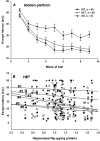
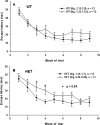
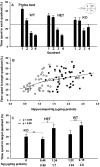


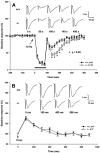
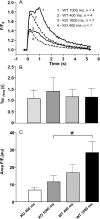

Similar articles
-
Participation of NMDA-mediated phosphorylation and oxidation of neurogranin in the regulation of Ca2+- and Ca2+/calmodulin-dependent neuronal signaling in the hippocampus.J Neurochem. 2003 Sep;86(6):1524-33. doi: 10.1046/j.1471-4159.2003.01963.x. J Neurochem. 2003. PMID: 12950461
-
Environmental enrichment enhances neurogranin expression and hippocampal learning and memory but fails to rescue the impairments of neurogranin null mutant mice.J Neurosci. 2006 Jun 7;26(23):6230-7. doi: 10.1523/JNEUROSCI.1182-06.2006. J Neurosci. 2006. PMID: 16763030 Free PMC article.
-
Involvement of neurogranin in the modulation of calcium/calmodulin-dependent protein kinase II, synaptic plasticity, and spatial learning: a study with knockout mice.Proc Natl Acad Sci U S A. 2000 Oct 10;97(21):11232-7. doi: 10.1073/pnas.210184697. Proc Natl Acad Sci U S A. 2000. PMID: 11016969 Free PMC article.
-
RC3/neurogranin, a postsynaptic calpacitin for setting the response threshold to calcium influxes.Mol Neurobiol. 1997 Oct;15(2):131-63. doi: 10.1007/BF02740632. Mol Neurobiol. 1997. PMID: 9396008 Review.
-
[Neurogranin: a brain-specific protein].Sheng Li Ke Xue Jin Zhan. 2003 Apr;34(2):111-5. Sheng Li Ke Xue Jin Zhan. 2003. PMID: 12889141 Review. Chinese.
Cited by
-
Increased prefrontal cortex neurogranin enhances plasticity and extinction learning.J Neurosci. 2015 May 13;35(19):7503-8. doi: 10.1523/JNEUROSCI.0274-15.2015. J Neurosci. 2015. PMID: 25972176 Free PMC article.
-
Ca(2+) sensor proteins in dendritic spines: a race for Ca(2+).Front Mol Neurosci. 2012 May 8;5:61. doi: 10.3389/fnmol.2012.00061. eCollection 2012. Front Mol Neurosci. 2012. PMID: 22586368 Free PMC article.
-
A Review of Proteins Associated With Neuroprotection and Regeneration in Alzheimer's Disease.Cureus. 2022 Oct 18;14(10):e30412. doi: 10.7759/cureus.30412. eCollection 2022 Oct. Cureus. 2022. PMID: 36407141 Free PMC article. Review.
-
Genome-wide Analysis of RARβ Transcriptional Targets in Mouse Striatum Links Retinoic Acid Signaling with Huntington's Disease and Other Neurodegenerative Disorders.Mol Neurobiol. 2017 Jul;54(5):3859-3878. doi: 10.1007/s12035-016-0010-4. Epub 2016 Jul 12. Mol Neurobiol. 2017. PMID: 27405468
-
Mechanisms of CaMKII action in long-term potentiation.Nat Rev Neurosci. 2012 Feb 15;13(3):169-82. doi: 10.1038/nrn3192. Nat Rev Neurosci. 2012. PMID: 22334212 Free PMC article. Review.
References
-
- Bernal J, Rodriguez-Pena A, Iniguez MA, Ibarrola N, Munoz A (1992) Influence of thyroid hormone on brain gene expression. Acta Med Austriaca 19 [Suppl 1]: 32-35. - PubMed
-
- Bhalla US, Iyengar R (1999) Emergent properties of networks of biological signaling pathways. Science 283: 381-387. - PubMed
-
- Chakravarthy B, Morley P, Whitfield J (1999) Ca2+-calmodulin and protein kinase Cs: a hypothetical synthesis of their conflicting convergences on shared substrate domains. Trends Neurosci 22: 12-16. - PubMed
-
- Cimler BM, Andreasen TJ, Andreasen KI, Storm DR (1985) P-57 is a neural specific calmodulin-binding protein. J Biol Chem 260: 10784-10788. - PubMed
-
- Cohen RW, Margulies JE, Coulter II PM, Watson JB (1993) Functional consequences of expression of the neuron-specific, protein kinase C substrate RC3 (neurogranin) in Xenopus oocytes. Brain Res 627: 147-152. - PubMed
MeSH terms
Substances
LinkOut - more resources
Full Text Sources
Molecular Biology Databases
Miscellaneous
